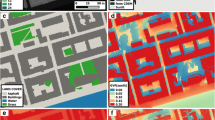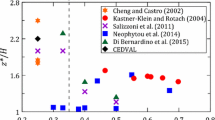Abstract
The roughness length for heat zT was evaluated over an urban canopy, using the measured sensible heat flux and radiometric temperature. To overcome thermal heterogeneity in the urban area, the measured radiometric temperature was transformed into the equivalent temperature of an upward longwave radiation flux. The equivalent temperature was found to provide an effective parameterization of the radiometric temperature. The daytime average of the resulting ln(zT/z0) was 10, where z0 is the aerodynamic roughness length. This result generally agrees with previous studies; however, the anthropogenic heat is a large uncertainty, which could cause an error at least 240% in zT.





Similar content being viewed by others
References
Arnfield AJ (1982) An approach to the estimation of the surface radiative properties and radiation budgets of cities. Phys Geogr 3:97–122
Brutsaert W (1982) Evaporation into the atmosphere. Reidel, Boston, MA, 299 pp
Brutsaert W, Sugita M (1996) Sensible heat transfer parameterization for surfaces with anisothermal dense vegetation. J Atmos Sci 53:209–216
Dyer AJ, Hicks BB (1970) Flux-gradient relationships in the constant flux layer. Q J R Meteorol Soc 32:205–236
Grimmond CSB, Oke TR (1999) Heat storage in urban areas: local-scale observations and evaluation of a simple model. J Appl Meteorol 38:922-940
Hagishima A, Tanimoto J, Narita K (2005) Intercomparisons of researches on experimental convective heat transfer coefficients and mass transfer coefficients of urban surfaces. Bound-Layer Meteorol 117:551–576
Ichinose T, Shimodozono K, Hanaki K (1999) Impact of anthropogenic heat on urban climate in Tokyo. Atmos Env 33:3897–3909
Johnson GT, Watson ID (1984) The determination of view-factors in urban canyons. J Climate Appl Meteorol 23:329–335
Kanda M, Moriwaki R, Roth M, Oke T (2002) Area-averaged sensible heat flux and a new method to determine zero-plane displacement length over an urban surface using scintillometry. Bound-Layer Meteorol 105:177–193
Kanda M, Kanega M, Kawai T, Moriwaki R, Sugawara H (2007) Roughness lengths for momentum and heat derived from outdoor urban-scale models. J Appl Meteorol Clim 46:1067–1079
Kikegawa Y, Genchi Y, Kondo H (2005) Impacts of the component patterns of air conditioning system and power supply system in buildings upon urban thermal environment in summer. Environ Sys Res 33:189–197
Kim YH, Baik JJ (2005) Spatial and temporal structure of the urban heat island in Seoul. J Appl Meteorol 44:591–605
Kneizys FX, Shettle EP, Abreu LW, Chetwynd Jr JH, Anderson GP, Gallery WO, Selby JEA, Clough SA (1988) User’s guide to LOWTRAN 7. Air Force Geophysics Laboratory Report, No. AFGL-TR-88–017, Air Force Geophysics Lab, Hanscom, MA, USA
Kondo H, Arisawa Y, Uno I, Ogata K, Kimura F, Saito A, Suzuki M, Takahashi S, Nakanishi M, Nakano Y, Mizuno T, Yasuraoka A, Yoshikado H, Liu FH, Wakamuatsu S (1994) Inter-conparison of the local circulation models: sea breeze cases (in Japanese). Tenki 41:751–760
Kusaka H, Kondo H, Kikegawa Y, Kimura F (2001) A simple single-layer urban canopy model for atmospheric models: comparison with multi-layer and slab models. Bound-Layer Meteorol 101:329–358
Macdonald RR, Griffiths RF, Hall DJ (1998) An improved method for estimation of surface roughness of obstacle arrays. Atmos Environ 32:1857–1864
Masson V (2000) A physically-based scheme for the urban energy budget in atmospheric models. Bound-Layer Meteorol 94:357–397
Matsushima D, Kondo J (1997) A proper method for estimating sensible heat flux above a horizontal–homogeneous vegetation canopy using radiometric surface observations. J Appl Meteorol 36:1696–1711
Moriwaki R, Kanda M (2004) Seasonal and diurnal fluxes of radiation, heat, water vapor, and carbon dioxide over a suburban area. J Appl Meteorol 43:1700–1710
Moriwaki R, Kanda M (2006) Scalar roughness parameters for a suburban area. J Meteorol Soc Japan 84:1063–1071
Narita K (2007) Experimental study of the transfer velocity for urban surfaces with a water evaporation method. Bound-Layer Meteorol 122:293–320
Schmid HP (1994) Source area for scalars and scalar fluxes. Bound-Layer Meteorol 67:293–318
Shepherd JM, Pierce H, Negri AJ (2002) Rainfall modification by major urban areas: observations from spaceborne rain radar on the TRMM satellite. J Appl Meteorol 41:689–701
Sugawara H (2001) Heat exchange between urban structures and the atmospheric boundary layer. PhD Thesis, Tohoku Univ., Aoba-ku, Sendai, Japan, 140 pp
Sugawara H, Takamura T (2006) Longwave radiation flux from an urban canopy: Evaluation via measurements of directional radiometric temperature. Rem Sens Environ 104:226–237
Sugawara H, Narita K, Mikami T (2001) Estimation of effective thermal property parameter on a heterogeneous urban surface. J Meteorol Soc Japan 79:1169–1181
Sun L, Mahrt L (1995) Determination of surface fluxes from the surface radiative temperature. J Atmos Sci 52:1096–1106
Takahashi T, Sekine K, Iwata T, Osaka T, Fukuwaki S (1981) Roughness parameter over Ogaki city (in Japanese). Geogr Rev Japan 54:579–594
Troufleau D, Lhomme JP, Montery B, Vidal A (1997) Sensible heat flux and radiometric surface temperature over sparse Sahelian vegetation I: an experimental analysis of the KB-1 parameter. J Hydrol 188–189:815–838
Voogt JA, Grimmond CSB (2000) Modeling surface sensible heat flux using surface radiative temperatures in a simple urban area. J Appl Meteorol 39:1679–1699
Voogt JA, Oke TR (1997) Complete urban surface temperature. J Appl Meteorol 36:1117–1132
Voogt JA, Oke TR (1998) Effects of urban surface geometry on remotely-sensed surface temperature. Int J Rem Sens 19:895–920
Yoshikado H (1990) Vertical structure of the sea breeze penetrating through a large urban complex. J Appl Meteorol 29:878–891
Yoshikado H (1992) Numerical study of the daytime urban effect and its interaction with the sea breeze. J Appl Meteorol 31:1146–1164
Acknowledgements
The authors would like to thank Dr. Mikami (Tokyo Metropolitan Univ., Japan) and Dr. Ushiyama (Tohoku Univ., Japan) for their great effort in the observations, and Dr. Ichinose (National Institute of Environmental Studies Japan) for providing the anthropogenic heat data. The Tokyo metropolitan government facilitated these observations, and the Japan Ground Self-Defense Force supported the airborne observation. This study was financially supported by Core Research for Evolutional Science and Technology of The Japan Science and Technology Cooperation.
Author information
Authors and Affiliations
Corresponding author
Rights and permissions
About this article
Cite this article
Sugawara, H., Narita, Ki. Roughness length for heat over an urban canopy. Theor Appl Climatol 95, 291–299 (2009). https://doi.org/10.1007/s00704-008-0007-7
Received:
Accepted:
Published:
Issue Date:
DOI: https://doi.org/10.1007/s00704-008-0007-7




